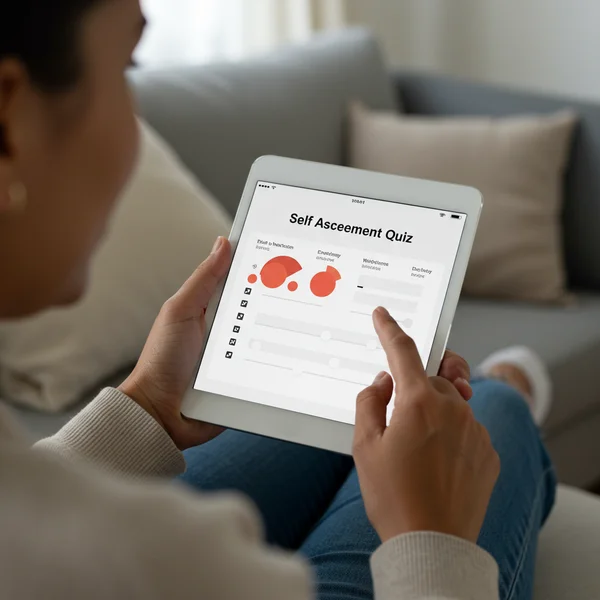Anhedonia Types: Social vs. Physical Pleasure Loss & How to Test for It
Do you feel a persistent emptiness, a world drained of color, or a strange disconnect from joy? Anhedonia, the inability to experience pleasure, can manifest in different ways, leaving you wondering why life feels so flat. Many people confuse this profound numbness with simple sadness or boredom, but it's a distinct experience that can significantly impact your well-being. Am I anhedonic? This is a question many silently ask themselves when the activities and connections that once brought them happiness now feel hollow.
Let's explore the two main types of anhedonia – social and physical – to help you pinpoint how pleasure might be eluding you. Recognizing these differences is a crucial first step toward understanding your emotional state and rediscovering your capacity for joy. If you're seeking clarity, a great starting point is to get instant insights with a structured self-assessment.
What is Anhedonia? Defining the Loss of Pleasure
Anhedonia is formally defined as a reduced ability to experience pleasure from positive stimuli. It’s a core symptom of major depressive disorder but can also appear in other conditions or on its own. It's not about being lazy or ungrateful; it’s a genuine change in your brain's reward system, making it difficult to feel the positive emotions that give life meaning and motivation.

More Than Just Sadness: Core Anhedonia Symptoms
Understanding anhedonia begins with recognizing that it goes beyond feeling down. While sadness is an active emotion, anhedonia is often characterized by its absence—an emotional numbness that blankets everything.
Common signs of anhedonia include:
- A loss of interest in hobbies and activities you once loved.
- Feeling detached or indifferent toward friends and family.
- A lack of motivation to pursue goals or engage in daily tasks.
- Difficulty feeling positive emotions like happiness, excitement, or contentment.
- A "flat" feeling, as if you're just going through the motions.
Why Understanding Anhedonia Types Matters for Your Well-being
Identifying whether your experience aligns more with social or physical anhedonia can provide valuable self-knowledge. This distinction isn't just academic; it helps you articulate your feelings to yourself and potentially to a healthcare professional. Knowing where your pleasure deficit lies can illuminate which areas of your life are most affected and guide you toward targeted strategies for improvement. It's about moving from a vague sense of "something's wrong" to a clearer understanding of your personal challenges.
Social Anhedonia: When Interactions Lose Their Spark
Social anhedonia specifically refers to a diminished capacity to experience pleasure from interpersonal situations. This includes everything from conversations with friends and family gatherings to intimate moments with a partner. People with social anhedonia don't necessarily dislike others; rather, they fail to derive the expected joy and reward from social connections. This is different from introversion, which is a personality trait where individuals prefer less social stimulation but can still enjoy it deeply.
Recognizing Symptoms of Social Disconnection and Withdrawal
How do you know if you might be experiencing social anhedonia? The signs often manifest as behavioral changes. You might find yourself actively avoiding social events you used to look forward to, or you might attend but feel completely disengaged, like an outsider looking in.
Key symptoms include:
-
Finding conversations with friends feel like a chore.
-
Feeling no warmth or connection during social gatherings.
-
Preferring to be alone not for rest, but to avoid the effort of interaction.
-
A reduced interest in forming new relationships or maintaining existing ones.

For those wondering if their social withdrawal is a sign of something more, taking a confidential social anhedonia test can provide a structured way to reflect on these experiences.
Impact on Relationships and Daily Life
The consequences of social anhedonia can be profound. Relationships may wither due to a perceived lack of interest or emotional investment. This can create a painful cycle: the less pleasure you get from socializing, the more you withdraw, leading to increased loneliness and further reinforcing the anhedonia. It can strain family ties, friendships, and romantic partnerships, leaving you feeling isolated even when surrounded by people.
Physical Anhedonia: Feeling Numb to Sensory Joys
In contrast, physical anhedonia is the inability to feel pleasure from sensory experiences. These are the tangible, bodily joys that often anchor us in the present moment—the taste of a favorite meal, the warmth of the sun, the beauty of a sunset, or the sound of beautiful music. When physical anhedonia takes hold, these experiences become flat and unrewarding.
How to Identify the Absence of Sensory Pleasure
Physical anhedonia can be subtle at first. You might not notice it until you realize that things that should feel good simply… don't. The rich aroma of coffee might not bring any comfort, a delicious dessert might taste like mere fuel, and a warm hug might feel empty of any emotional warmth. It’s a loss of the body's ability to translate sensory input into feelings of pleasure and contentment. An emotional numbness test can often help clarify if this loss of sensory feedback is a significant part of your experience.

Everyday Activities That Now Feel Flat
This form of anhedonia drains the color from daily life. A walk in nature might lose its restorative power, listening to your favorite album may evoke no emotion, and even the simple pleasure of a hot shower can feel mundane. It affects your motivation to engage in activities that rely on sensory feedback, from exercise to creative pursuits, making it difficult to find sources of everyday happiness.
Differentiating Anhedonia Types: A Clearer Picture
While social and physical anhedonia target different sources of pleasure, they both stem from a similar root: a disruption in the brain's reward processing. Understanding their differences is key to forming a complete picture of your emotional health.
Key Distinctions and Overlaps Between Social and Physical Anhedonia
The primary distinction is the source of the lost pleasure:
- Social Anhedonia: Affects rewards from interpersonal interactions.
- Physical Anhedonia: Affects rewards from sensory and bodily experiences.
You might experience just one type, or both at the same time. For example, someone might still enjoy the taste of a great meal (no physical anhedonia) but feel nothing when praised by their boss (social anhedonia). Conversely, someone might love spending time with friends but find no pleasure in hobbies like cooking or listening to music. Often, in cases of anhedonia depression, both types are present to some degree.
Self-Assessment: Is Your Experience Social, Physical, or Both?
Take a moment to reflect. When you think about things that used to bring you joy, which ones now feel empty? Are you missing the laughter with friends, or the simple pleasure of a good meal? Or perhaps both? Answering these questions is a powerful form of self-assessment. For a more structured and scientific approach, a well-designed anhedonia quiz can help you measure these different facets of your experience with greater precision.

Taking the First Step Towards Rediscovering Joy
Understanding the specific nature of your pleasure loss—whether it's social, physical, or a combination—is not a diagnosis, but an empowering act of self-discovery. It gives you the language to describe your inner world and provides a starting point for seeking change. This knowledge is the first step on the path toward reconnecting with the joys of life.
If what you've read resonates with you, you don't have to remain in uncertainty. You can gain clearer, personalized insights right now. We invite you to take our free, confidential, and scientifically-based anhedonia test. It's designed to help you understand your experience and provide a foundation for your next steps. Start your self-assessment today and rediscover your capacity for joy.
Your Questions About Anhedonia Types Answered
How do you test for anhedonia?
Anhedonia is clinically assessed by mental health professionals using interviews and validated questionnaires, like the Snaith-Hamilton Pleasure Scale (SHAPS). For self-assessment, you can use a confidential online tool like our free anhedonia test, which is based on these scientific scales to provide you with instant, reliable insights.
What is the root of anhedonia?
The root of anhedonia is complex and not fully understood, but it's believed to involve dysfunction in the brain's reward circuit, particularly involving the neurotransmitter dopamine. It can be triggered by chronic stress, trauma, inflammation, and is a key symptom of mental health conditions like depression, schizophrenia, and PTSD.
Does anhedonia ever go away?
Yes, anhedonia can improve and often does go away with the right support and strategies. Treatment often involves addressing the underlying condition through therapy (like Cognitive Behavioral Therapy or Behavioral Activation), lifestyle changes (exercise, mindfulness), and sometimes medication prescribed by a doctor. Recognizing it is the first step toward recovery.
What are the symptoms of social anhedonia?
The primary symptoms of social anhedonia include a lack of enjoyment from social interactions, feeling detached from others, preferring to be alone to an extreme degree, and having little interest in forming or maintaining relationships. It’s a profound lack of reward from what are typically rewarding human connections.
Can people with anhedonia cry?
Yes, people with anhedonia can often still cry. Anhedonia is primarily about the inability to feel pleasure or positive emotions. The capacity to feel negative emotions like sadness, frustration, or grief may remain intact, and crying is a natural response to these feelings. However, some may experience a broader emotional numbness that affects all feelings, including the ability to cry.